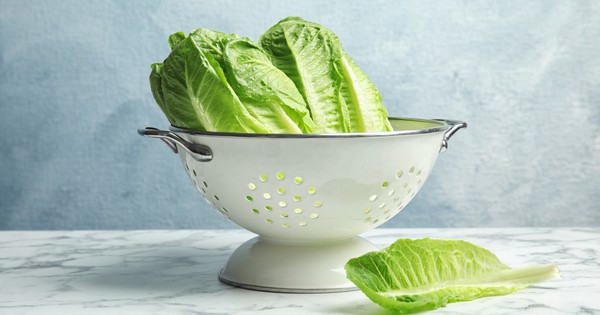9 tips to avoid illness from salad greens

In a cruel twist of irony, some of the world’s healthiest food – leafy greens – have become some of the riskiest in terms of foodborne illness.
This is so on-brand for modern humans. Seventeen of the top 20 most nutrient-dense fruits and vegetables are leafy greens (according to research from the CDC) – but because of our broken food system, leafy greens are one of the foods most susceptible to foodborne illness pathogens.
Leafy greens are linked to reduced risk of heart disease, cancer, macular degeneration, and type 2 diabetes, as well as potential cognitive benefits. Yet between 2006 and 2019, leafy greens were involved in at least 46 multistate E. coli outbreaks, according to the CDC. And that’s just E. coli.
“We face a real dilemma with leafy greens, especially romaine lettuce,” says James E. Rogers, Ph.D., director of food safety research and testing at Consumer Reports (CR). “They’re packed with nutrients, so we don’t want to discourage people from eating them. But we can’t ignore the fact that leafy greens are potentially risky, perhaps one of the riskiest foods.”
Rogers says that even though the odds that you will actually get sick are low, “they’re real.” Given their enormous health benefits, avoiding leafy greens altogether is not a great option – but there are ways to reduce one’s risk, writes Kevin Loria writes for CR. The following tips are culled from CR and the CDC and can help you get the healthy leafy greens you need, without the pesky food poisoning.
1. Know your risks
Some people are more likely to get sick and/or have a more severe illness. For people in these groups, extra precaution is warranted: Children younger than age 5; pregnant women; adults aged 65 and older; and people with weakened immune systems.
2. Buy the whole head
Even though most packaged greens have been washed, they have also gone through more processing and handling than whole lettuces, and thus have more opportunity for contamination. Think of it this way, inner leaves on a head will not have been handled at all. One analyses of 208 pre-washed salad mixes found they had “bacteria that are common indicators of poor sanitation and fecal contamination – in some cases, at rather high levels.” Plus, this: 7 reasons to ditch packaged greens.
3. Consider hydroponic or greenhouse
CR suggests buying greens grown hydroponically or in a greenhouse. “These are less likely to be contaminated by bacteria from animal droppings in soil or water, although they’re not risk-free,” writes Loria. Of course this isn’t foolproof; they will still require clean water and proper food safety during processing. Added bonus, they may be more local. Shipping field-grown lettuce from the west to the rest of the country is ridiculously resource-intensive; see more here.
4. In fact, go local or grow your own
As I wrote in “How to avoid getting E. coli’: Get greens from as close to the source as you can. If you can buy a whole head of lettuce from a farmer at a greenmarket – or best yet, grow it yourself! – think of how many of those points of potential contamination are eliminated.
5. Keep it cool
If you buy packaged lettuce, treat it as a “keep refrigerated” item. In fact, CDC reminds us to refrigerate all produce that is purchased pre-cut or packaged. “As you would with meat and poultry, don’t let bagged lettuce stay out of the fridge for too long, because bacteria multiply at room temperature,” says CR’s Rogers. Also note that the longer packaged greens sit in their packages, the more time bacteria have to grow – so try to only buy enough to last for a few days.
6. Rinse greens in vinegar
Aw, vinegar, the miracle potion! CR explains that research shows that soaking greens in vinegar or a vinegar-water solution will reduce bacteria levels – even if it won’t decimate all bacteria. You can splash your greens with vinegar and let them sit for 10 minutes, then rinse.
7. Take care in washing pre-washed greens
The CDC says that you do not have to wash pre-washed greens. Even if you want to be extra careful, I wondered? Yes, because you run the risk of cross-contamination in your kitchen. The FDA says that if you choose to wash produce marked as “pre-washed” or “ready-to-eat,” “be sure that it does not come in contact with unclean surfaces or utensils. This will help to avoid cross contamination.”
8. Cook ’em
Well thankfully wilted (aka cooked) salad greens are trendy; and once you get over the weirdness of cooking your salad (is it still a salad?) – cooked salad greens are delicious. CR points out that cooking your greens will kill harmful bacteria, but “it’s a solution only for sturdier greens, such as spinach, kale, collards, and Swiss chard.”
9. Keep your ears open
Staying up to date on food recall news is a good way to stay on top of foodborne illness outbreaks. The FDA’s Recalls, Market Withdrawals & Safety Alerts page lists all recent recall information by product area, including food and other items. And Foodsafety.gov lists recall information from both the FDA and the USDA.For a comprehensive look at how are greens are getting contaminated, visit CR’s Leafy Greens Safety Guide. And in the meantime, I’m going to go cook my salad.
In a cruel twist of irony, some of the world’s healthiest food – leafy greens – have become some of the riskiest in terms of foodborne illness.
Please enable JavaScript to view the comments.







